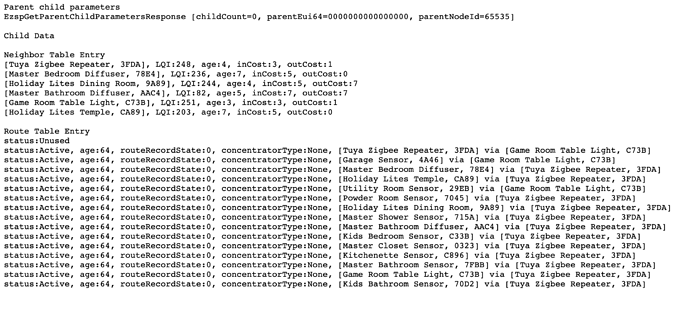So I unpaired those four GE Zigbee bulbs, physically removed and replaced them with dumb bulbs. They are completely out of the picture now.
I can't say for certain that there was an improvement in my Zigbee mesh. The Zigbee blinds drivers that I use seem more responsive, but I can't tell for sure since their performance has always been hit or miss.
In the interim, I upgraded Hubitat to the latest version.
I reran the output of the zigbee Child/Route Info. Here is what I got:
Parent child parameters
EzspGetParentChildParametersResponse [childCount=0, parentEui64=0000000000000000, parentNodeId=65535]
Child Data
Neighbor Table Entry
[Tuya Zigbee Repeater, 3FDA], LQI:248, age:4, inCost:3, outCost:1
[Master Bedroom Diffuser, 78E4], LQI:236, age:7, inCost:5, outCost:0
[Holiday Lites Dining Room, 9A89], LQI:244, age:4, inCost:5, outCost:7
[Master Bathroom Diffuser, AAC4], LQI:82, age:5, inCost:7, outCost:7
[Game Room Table Light, C73B], LQI:251, age:3, inCost:3, outCost:1
[Holiday Lites Temple, CA89], LQI:203, age:7, inCost:5, outCost:0
Route Table Entry
status:Unused
status:Active, age:64, routeRecordState:0, concentratorType:None, [Tuya Zigbee Repeater, 3FDA] via [Game Room Table Light, C73B]
status:Active, age:64, routeRecordState:0, concentratorType:None, [Garage Sensor, 4A46] via [Game Room Table Light, C73B]
status:Active, age:64, routeRecordState:0, concentratorType:None, [Master Bedroom Diffuser, 78E4] via [Tuya Zigbee Repeater, 3FDA]
status:Active, age:64, routeRecordState:0, concentratorType:None, [Holiday Lites Temple, CA89] via [Tuya Zigbee Repeater, 3FDA]
status:Active, age:64, routeRecordState:0, concentratorType:None, [Utility Room Sensor, 29EB] via [Game Room Table Light, C73B]
status:Active, age:64, routeRecordState:0, concentratorType:None, [Powder Room Sensor, 7045] via [Tuya Zigbee Repeater, 3FDA]
status:Active, age:64, routeRecordState:0, concentratorType:None, [Holiday Lites Dining Room, 9A89] via [Tuya Zigbee Repeater, 3FDA]
status:Active, age:64, routeRecordState:0, concentratorType:None, [Master Shower Sensor, 715A] via [Tuya Zigbee Repeater, 3FDA]
status:Active, age:64, routeRecordState:0, concentratorType:None, [Master Bathroom Diffuser, AAC4] via [Tuya Zigbee Repeater, 3FDA]
status:Active, age:64, routeRecordState:0, concentratorType:None, [Kids Bedroom Sensor, C33B] via [Tuya Zigbee Repeater, 3FDA]
status:Active, age:64, routeRecordState:0, concentratorType:None, [Master Closet Sensor, 0323] via [Tuya Zigbee Repeater, 3FDA]
status:Active, age:64, routeRecordState:0, concentratorType:None, [Kitchenette Sensor, C896] via [Tuya Zigbee Repeater, 3FDA]
status:Active, age:64, routeRecordState:0, concentratorType:None, [Master Bathroom Sensor, 7FBB] via [Tuya Zigbee Repeater, 3FDA]
status:Active, age:64, routeRecordState:0, concentratorType:None, [Game Room Table Light, C73B] via [Tuya Zigbee Repeater, 3FDA]
status:Active, age:64, routeRecordState:0, concentratorType:None, [Kids Bathroom Sensor, 70D2] via [Tuya Zigbee Repeater, 3FDA]



